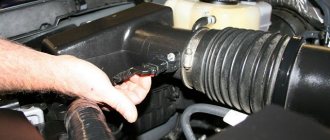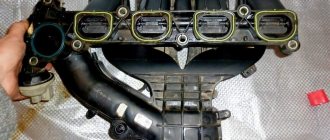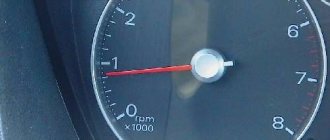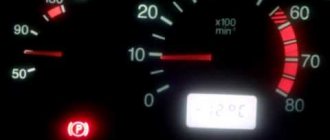In hot weather or just in the summer, the car drives simply amazing, but after a while the revolutions begin to drop, the car does not pull, the temperature is normal, I brake, stand for five minutes, rest, start it and drive normally. About 20-30 minutes, then everything repeats again, the check is not displayed. In cool weather in winter everything is fine, there is no such thing. Last year there was exactly the same malfunction, but then a check was displayed, and the malfunction came out on its own: the brushes on the starter were worn out. After replacement, I drove it and didn’t know any grief. But now I don’t know what to think, maybe you can tell me? Vladimir.
Hello, Vladimir. Symptoms such as those occurring in your car cannot indicate a specific breakdown. Here you need to look at the car to find out exactly why you are losing speed when driving.
We will give you some recommendations:
- First you need to check the operation of the fuel pump. Apparently, this is where the problem lies. When you experience symptoms of “sickness” again while moving, take a wet cloth and place it directly on it. If the idle speed levels out and the engine starts running well again, then it is most likely time to replace the fuel pump. In addition, we recommend that you check the pump screen, which is also considered a fuel filter. Clean it, as it is often the cause of unstable engine operation.
A clogged mesh (fuel filter) can also cause the car to lose power when driving.
- Re-diagnostics of the car. You may be having problems with your starter again. Or maybe the malfunction lies in incorrectly functioning sensors: throttle position, idle speed control, mass air flow, coolant temperature, crankshaft position. In total, incorrect operation of several devices can cause a loss of power when driving. In any case, if you have such problems, then diagnosis is the first thing to do.
- Often with such problems, the malfunction lies in incorrectly functioning ignition coils. Check their functionality.
- If the speed drops when the cooling fan turns on, then look for an electrical problem. In this case, the problem is directly related to the electrical circuit. There is a possibility that vehicle diagnostics will show you an insufficient voltage level in the on-board network at idle. Perhaps the problem lies in the incorrect operation of the thermostat, which is installed in the voltage regulator. If this is the case, then install a three-level voltage regulator on your car and you will forget about all the problems.
Good luck to you. We hope our tips are useful to you.
Idle speed on an injection engine
To solve this problem, you need to understand how idle speed works on an injection engine.
The entire operation of a modern power unit is controlled by an electronic unit (ECU), which uses the readings of various sensors installed on the engine crankcase. Several such parts are responsible for idling, namely:
- idle speed control valve;
- a sensor responsible for regulating the throttle position;
- air flow meter entering the intake manifold (MAF);
- EGR exhaust gas afterburning valve.
Each of them has a specific functionality and can affect the engine speed without load. The ECU receives data from these nodes and, processing it, selects the optimal operating mode of the car engine.
Sometimes the cause of a malfunction in which the idle speed drops may be the failure of any sensor. In case of such a breakdown, it is best to contact a car service station, which has specialized diagnostic equipment and is able to quickly identify the defective part. If this is not possible, you will have to conduct your own search. And they should start with the idle speed control valve.
Low pressure in the fuel rail.
Another reason when there is no idle, or poor idle and the car jerks and drives poorly is insufficient pressure in the fuel rail. The pressure must be measured using a pressure gauge, cutting into the fuel line where the fuel rail and the line from the fuel pump meet.
What pressure should be in the fuel rail? Here it is already necessary to look at the manual for this car, since in many cars the pressure in the fuel rail is different.
I have met many craftsmen who repair cars at random, that is, by replacing everything in a row, by elimination. But you just need a correct and logical approach, and it wouldn’t hurt to understand how injection engines work. Agree - it’s easier and cheaper to measure the pressure in the fuel rail than to immediately change the fuel pump. I think it won’t be difficult to find a guide on exactly what pressure should be in your car. It is very easy to measure the pressure and rule out or judge the fuel pump to be faulty. So before spending money on buying new parts, always properly diagnose a particular part first.
Idle air control valve or IAC
The IAC is a small electric motor in which a cone-shaped needle is placed on a spring. It is designed to supply air to the engine power system, which is necessary to form the proper quality of the air-fuel mixture, making it lean. It is connected to the mass air flow sensor and, receiving a signal from the ECU, opens, providing air flow without using the throttle valve, which changes position when the gas pedal is pressed.
Having rather fragile parts and being located in the engine intake manifold, the regulator is subject to the formation of various deposits on the needle, which impedes its movement, which leads to failure of this part.
Checking the performance of the IAC is quite simple; to do this, you need to use a tester and check its resistance readings on a warm engine. The operating resistance should be in the range from 40 to 80 ohms. If it is not, then it is faulty and needs to be replaced.
Another characteristic sign of a regulator failure is that when the engine is hot, it begins to stall as soon as the gearbox is switched off while driving.
The IAC cannot be repaired, so it is simply replaced with a new part. If the regulator resistance indicator is normal, then it is worth checking the mass air flow sensor.
Tips and tricks
Let's look at how you can eliminate some of the malfunctions that lead to floating and speed jumps, and do it yourself.
- As mentioned above, the leakage of excess air can cause surges. To exclude or confirm the possibility of supplying such air, you need to check the tightness of the air supply system to the intake. You can remove the air hose and feed it air from a compressor or pump by placing the hose in a container of water. This method helps to identify cracks.
- As for the idle air control, you need to measure the resistance with a multimeter. If the resistance is between 40 and 80 ohms, this means that the device is not working.
- Also, as part of diagnostic procedures, in some cases it is necessary to clean the crankcase ventilation valve. The valve must be removed and washed with carburetor cleaning fluid or kerosene. This approach will remove deposits from the valve.
- As for the ECM sensors, in this case it is not advisable to try to repair such elements. For example, if the mass air flow sensor is faulty, it is better to immediately replace it with a new one.
- It is better to trust specialists to flush the throttle valve without proper experience, especially if such flushing is necessary with the removal of the valve. If we talk about the method of flushing the throttle without removing it, you can do the procedure yourself. The hoses are disconnected from the valve, then a cleaning aerosol is injected into the throttle.
The main thing is to disconnect the electrical contacts from the throttle valve. Let us add that on many cars where the damper was heavily dirty, you then need to additionally set the correct opening gap of the damper or “teach” the throttle using the appropriate equipment.
- On a car with a carburetor, you need to adjust the idle speed by setting it with the quality and quantity screws on the carburetor. The idle jet may also need to be cleaned. To do this, it is often enough to inject a carburetor cleaning aerosol and then blow it with compressed air.
According to drivers, this helps protect the pump from corrosion and is a preventative measure. At the same time, we note that this method is suitable for construction equipment and it is highly not recommended to practice such solutions on modern diesel internal combustion engines.
The role of the mass air flow sensor (MAF)
This device is designed to measure air, a certain amount of which is supplied to the manifold for mixing with gasoline. In appearance, it is a metal mesh and a measuring element placed in it with a four-pin power connector. The measuring element is equipped with a platinum string, which acts as a heat exchanger. It is cooled by the air flow coming from the air filter, and heated by supplying electricity to it; the stronger the air flow, the more electricity is supplied to the platinum.
If the DMVR fails, the electronic unit does not receive a signal about the incoming air volume, and the unit is not able to provide the required engine operating mode.
It is not difficult to check it on a warm engine; to do this, you need to disconnect the power connector from the sensor and start the engine. With this option, the electronic unit will select emergency mode and increase the number of crankshaft revolutions to 1500 per minute. After driving a car for several kilometers and realizing that the car has become much more responsive, you can identify a malfunction of the mass air flow sensor and the need to replace it.
To be more convincing, you can use a tester, switching it to the maximum two-volt constant voltage mode. After that, turning on the ignition in the car, the red wire of the tester is connected to the yellow wire of the mass flow sensor connector, and the black wire to the green. The tester should show a value from 101 to 103, which means that it is working. If above 105, the sensor is faulty and requires replacement.
The cause of failure of this part is most often an excessively clogged air filter and a malfunction of the crankcase ventilation of the power unit.
Sensor that regulates the throttle position (TPV) and its mechanism
This element, guided by a signal from the control unit, begins to open the throttle valve, which provides more gasoline and air to form the fuel mixture.
During idling, the throttle is completely closed, blocking the air flow. Any malfunction in this mechanism will cause the crankshaft speed to fluctuate sharply on a warm engine.
The breakdown of any part of this mechanism negatively affects the performance of the power unit. A malfunction in the throttle sensor manifests itself in its inability to control opening or closing, while the damper does not respond to the signal, remaining in one position. As a result, a large amount of oxygen enters the gasoline, which excessively leans the mixture, making it unsuitable for ignition in the combustion chamber of the engine. You can check the operation of the TPS with a tester. To do this, the car starts, and the black wire on the tester is connected to the car body, and the red wire is connected to the TPS contact number 1 or letter A. It should show a value from 4.8V to 5.2V. Any deviation from this norm indicates a malfunction in the power supply to the TPS.
Next, proceed to check the resistance with the throttle valve closed and open. To do this, close the remaining terminals with the multimeter wires and look at its value, which when closed is from 0.9 to 1.2 kOhm, and when open – no more than 2.7 kOhm. Any deviation means the TPS is broken and needs to be replaced.
The movement of the damper itself is also checked, which should be free. Any jamming of the damper must be eliminated by removing the resulting carbon deposits and other contaminants.
Let's sum it up
Modern cars must operate accurately in the modes established by the manufacturer. Otherwise, after a few years of operation, you will have to overhaul the engine or replace the entire unit. The issue of warm-up speed is very important, and many do not pay enough attention to it. The problem is that few people read the instructions. Many car owners rely solely on advice from friends, unverified technicians, or forum participants. But you must understand that only you yourself are responsible for the health of your car and the engine in particular. Therefore, it is worth checking all possible problems and not being lazy to sometimes show up for diagnostics. In this case, you will always find and fix problems on time.
If the warm-up algorithm changes with the change of season, there is a high probability that everything is absolutely normal with the car. But if there is an unexpected change in mode and dramatic changes in the behavior of the engine after starting, you need to think about possible problems. Warming up problems will not always be solved by replacing expensive sensors. You may need to fix the firmware or find a broken contact in one of the places in the car's electrical circuit. Have you ever encountered problems with the absence or inadequate behavior of the warm-up mode?
EGR system
This system is designed to return some of the exhaust gases back into the cylinders to improve ignition in the combustion chambers. On a warm engine, its malfunction can lead to sudden jumps in idle speed. The main purpose of EGR is to reduce toxic emissions into the atmosphere. Due to constant exposure to elevated temperatures, the EGR valve becomes clogged, which leads to floating crankshaft speeds. Fix the breakdown by simply cleaning the seat on the valve; if this does not help, then it needs to be replaced.
What are the reasons for the drop in turnover?
Many car enthusiasts do not pay attention to the condition of their cars, much less the engine. Often, the consequences can be expressed in malfunctions, which will develop into major repairs, which will cost a considerable amount of money . It is for these reasons that if a malfunction occurs with the engine, it is necessary to return it to normal functionality.
So, let's look at the main reasons that lead to low idle speed:
- The adjustment of the “quantity” and “quality” screws is broken
A common cause of low idle speed on Ozone carburetors. Often, tightening the fuel adjustment screws is enough to restore normal speed.
- Fuel level is incorrectly adjusted
In addition to a drop in engine speed at idle, this leads to a drop in power. The engine may stall or start after much suffering. Long-term operation on lean fuel can lead to engine failure.
- Foreign air enters the carburetor
The “suction” of excess air can interfere with engine operation. Another option is that the air filter is dirty and not enough air is getting in.
Engines designed to consume high-quality fuel may malfunction or fail if they are “fed” with lower quality fuel, for example, 92 instead of 95. Moreover, the engine may encounter a lot of new problems that will have to be solved, so it is better to use good gasoline.
- On-board computer malfunctions
It also happens that the on-board computer begins to show inaccurate data. If everything seems to be fine with the engine, but the electronics persistently indicate that there is a problem, you can try to connect a working BC and check it on it.
- It's time to change the spark plugs
Determining the cause of the malfunction
The following steps will help you determine the reason why the idle speed has dropped.
- If there are no additional signs of a drop in speed (for example, vibration), you can check the engine on another on-board computer.
- Check sensors.
- Inspect the spark plugs.
- Make sure the fuel and idle levels are adjusted correctly
- Make sure that excess air is not “sucked” into the carburetor.
- Inspect the air filter for contamination.
It's time to service the carburetor - minor defects
The reason for the drop in speed during warming up can also be minor breakdowns in the carburetor system. These are torn membranes, dislodged cable fastenings or a sticking damper drive. Such troubles can be cured during an inspection of this device. In the old days, every second car driver could independently rebuild the carburetor, install a repair kit and drive on, listening to the contented rumbling of the unit. Today the repair principle is as follows:
- you should go to a car store or market to find a suitable repair kit for your type of carburetor; it is better to take original high-quality parts;
- Next, it is important to find a master who is well versed in carburetors and can help with troubleshooting problems in your device; there are fewer and fewer such masters in cities;
- In a few tens of minutes, a specialist will go through the equipment, find the problem and install new gaskets, membranes, seals and other products from the repair kit;
- Next, you need to check the equipment to make sure there are no unpleasant effects; often this can only be done the next day on a cooled car;
- the last step is regular visits to the technician once every 2 years for maintenance and inspection of the carburetor, this will keep the car in normal working condition for a long period.
Carburetor fuel injection has its advantages. You will have to pay a fortune for maintenance and cleaning of the injector. But carburetor repair, even with the replacement of certain parts, will not cost too much. But to get these benefits, you should find a technician who is well acquainted with the features of your particular car model. Such a specialist will help you fix all the problems and continue to operate the machine without problems.
Approaches to solving the problem
When all the causes have been identified, you can proceed to troubleshooting. Of course, there are a different number of ways to solve the problem, but do not forget that a certain sequence of actions is necessary. It is worth considering the issue in more detail.
Adjust fuel level and idle speed
Adjusting the idle speed on Ozone carburetors. You will need a tachometer and a slotted screwdriver. Work must be carried out on a warm engine. By turning the “quantity” screw in the clockwise direction, you can achieve an increase in speed.
If it is not possible to solve this problem with one “quantity” screw, you need to connect a “quality” screw, which, if it has not been used yet, may have a factory plug on it. It can be pulled out by screwing a suitable screw into the plastic and pulling it out.
Adjustment is usually carried out in 2-3 (several) passes.
Replace spark plugs
Even if the spark plugs have recently been replaced, they may be of poor quality or defective. Original spare parts are always better than cheaper analogues. A falling XX often hints at this malfunction.
Change fuel
Using sensors, it is necessary to check the pressure in the fuel supply system and the presence of contaminants. After which you need to change the fuel to a cleaner and higher quality one. As a last resort, you should consider refueling at a gas station of another company.
Check air and fuel filters
The air filter may be dirty. As the filter becomes dirty, the amount of air entering the engine decreases. Engine power decreases and fuel consumption increases significantly.
The air filter needs to be cleaned or, more importantly, replaced. It is best to carry out this procedure in advance to avoid other problems in the future.
Clean the idle speed sensor
If oil and other contaminants enter the sensor, it will fail. The sensor is cleaned with carburetor cleaner and aerosol liquid. The device must be removed and washed. The aerosol liquid gently cleans the needle. Be careful that liquid does not get into the inside (that is, under the spring), to avoid its failure.
Why does the engine oil pressure light blink on a warm GAZ engine?
The warning light in the lubrication system is a visual indicator not of the lubricant level, but of the readings of the sensor located in the main oil line. The light comes on when there is no or low pressure in the line. This picture is very dangerous for critical engine components, because it can lead to scuffing on the journals of the camshaft and crankshaft.
It is also possible for the anti-friction material of the liners to melt. Ignoring the warning signal may lead to jamming of the shafts or rotation of the bearings. Therefore, the light signal should be perceived as an emergency signal. It is better to cancel the trip and find out the causes of the problem.
Of course, first of all we check the presence and level of lubricating fluid. When it is not enough, add it, start the engine and check whether the oil pressure lamp blinks on a warm engine or not. If the light goes out, then we rejoice and go about our business in the car. If everything remains the same as before, then you will have to check a number of reasons:
- Test the functionality of the lubricant pressure controller by connecting a pressure gauge in its place.
- The oil pump gears may be worn.
- If the engine has significant mileage, then it is possible that fuel will leak into the crankcase through a broken fuel pump membrane. As a result, the oil becomes liquid and the pressure in the oil line drops.
- The viscosity of the filled lubricant does not match the recommended one. When heated, it becomes too liquid and seeps through the gaps.
- Remove the oil pan and inspect the oil filter; if it is too dirty, wash or replace the part.
Some motorists ignore the lubricant pressure warning light. This is completely wrong - first of all, you should check the sensor and oil filter. As real practice shows, the malfunction of these particular parts is the reason for the light bulb to light up. If the check does not reveal any defects in the listed parts, then the problem most likely lies in the wear of the crankshaft parts.
Conclusion
A drop in engine speed is a fairly common problem. It can happen not only for any one reason - when the engine is severely worn out, an integrated approach is required, and the breakdowns can be quite specific. In this case, you may need to seek professional help.
When purchasing a car, few people think about the need for timely maintenance. Failure to do this leads to periodic breakdowns of its various mechanisms and power unit.
One of the most common malfunctions associated with improper maintenance is improper operation of a warm engine idling.
This article will help you figure out why this happens.
How does a car generator work?
Even at the dawn of the automotive industry, recharging the battery was not the only function of the generator - even then there were consumers of electric current in the form of headlights.
A modern car needs electricity to a much greater extent, and the generator is its supplier. This device, using the energy of rotation of the crankshaft, converts it into electricity. The generation of alternating current is carried out due to the rotation of the rotor, which forms an alternating magnetic field in the stator winding - this is the operating principle of any generator.
But since engine speed is not a constant value, there is a need to dynamically change the power produced by the generator. The voltage regulator is responsible for this.
The generator is turned on when the engine is started; the connection between the crankshaft rotation speed and the operation of the generator is quite obvious. But how can a voltage drop in the on-board electrical network affect the engine?
Idle speed on an injection engine
To solve this problem, you need to understand how idle speed works on an injection engine.
The entire operation of a modern power unit is controlled by an electronic unit (ECU), which uses the readings of various sensors installed on the engine crankcase. Several such parts are responsible for idling, namely:
- idle speed control valve;
- a sensor responsible for regulating the throttle position;
- air flow meter entering the intake manifold (MAF);
- EGR exhaust gas afterburning valve.
Each of them has a specific functionality and can affect the engine speed without load. The ECU receives data from these nodes and, processing it, selects the optimal operating mode of the car engine.
Sometimes the cause of a malfunction in which the idle speed drops may be the failure of any sensor. In case of such a breakdown, it is best to contact a car service station, which has specialized diagnostic equipment and is able to quickly identify the defective part. If this is not possible, you will have to conduct your own search. And they should start with the idle speed control valve.
Floating speed with a faulty oxygen sensor
An oxygen sensor, or lambda probe, measures the oxygen content in the exhaust gases and, based on the data obtained, determines the quality parameters of the working mixture, giving a signal to deplete or enrich it. The device works normally only after it warms up to operating temperature - at least 300 degrees. Therefore, most of them are supplemented with an indirect heating system to speed up the process. Failure of heating or contamination of the working surfaces of the sensors with combustion products causes inaccuracies in determining the oxygen content, as a result of which engine operation will be unstable.
Idle air control valve or IAC
The IAC is a small electric motor in which a cone-shaped needle is placed on a spring. It is designed to supply air to the engine power system, which is necessary to form the proper quality of the air-fuel mixture, making it lean. It is connected to the mass air flow sensor and, receiving a signal from the ECU, opens, providing air flow without using the throttle valve, which changes position when the gas pedal is pressed.
Having rather fragile parts and being located in the engine intake manifold, the regulator is subject to the formation of various deposits on the needle, which impedes its movement, which leads to failure of this part.
Checking the performance of the IAC is quite simple; to do this, you need to use a tester and check its resistance readings on a warm engine. The operating resistance should be in the range from 40 to 80 ohms. If it is not, then it is faulty and needs to be replaced.
Another characteristic sign of a regulator failure is that when the engine is hot, it begins to stall as soon as the gearbox is switched off while driving.
The IAC cannot be repaired, so it is simply replaced with a new part. If the regulator resistance indicator is normal, then it is worth checking the mass air flow sensor.
The role of the mass air flow sensor (MAF)
This device is designed to measure air, a certain amount of which is supplied to the manifold for mixing with gasoline. In appearance, it is a metal mesh and a measuring element placed in it with a four-pin power connector. The measuring element is equipped with a platinum string, which acts as a heat exchanger. It is cooled by the air flow coming from the air filter, and heated by supplying electricity to it; the stronger the air flow, the more electricity is supplied to the platinum.
Sensor that regulates the throttle position (TPV) and its mechanism
This element, guided by a signal from the control unit, begins to open the throttle valve, which provides more gasoline and air to form the fuel mixture.
During idling, the throttle is completely closed, blocking the air flow. Any malfunction in this mechanism will cause the crankshaft speed to fluctuate sharply on a warm engine.
The breakdown of any part of this mechanism negatively affects the performance of the power unit. A malfunction in the throttle sensor manifests itself in its inability to control opening or closing, while the damper does not respond to the signal, remaining in one position. As a result, a large amount of oxygen enters the gasoline, which excessively leans the mixture, making it unsuitable for ignition in the combustion chamber of the engine. You can check the operation of the TPS with a tester. To do this, the car starts, and the black wire on the tester is connected to the car body, and the red wire is connected to the TPS contact number 1 or letter A. It should show a value from 4.8V to 5.2V. Any deviation from this norm indicates a malfunction in the power supply to the TPS.
Next, proceed to check the resistance with the throttle valve closed and open. To do this, close the remaining terminals with the multimeter wires and look at its value, which when closed is from 0.9 to 1.2 kOhm, and when open – no more than 2.7 kOhm. Any deviation means the TPS is broken and needs to be replaced.
The movement of the damper itself is also checked, which should be free. Any jamming of the damper must be eliminated by removing the resulting carbon deposits and other contaminants.
EGR system
This system is designed to return some of the exhaust gases back into the cylinders to improve ignition in the combustion chambers. On a warm engine, its malfunction can lead to sudden jumps in idle speed. The main purpose of EGR is to reduce toxic emissions into the atmosphere. Due to constant exposure to elevated temperatures, the EGR valve becomes clogged, which leads to floating crankshaft speeds. Fix the breakdown by simply cleaning the seat on the valve; if this does not help, then it needs to be replaced.











